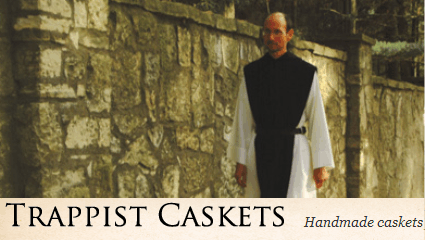One of the products Trappist Caskets sells is Made in America Caskets. A more complete list of their products is provided by Made in America Secrets, to review their list click here.
For more information about Trappist Caskets and its American Made products see the following:
In July 1849, Abbot Dom Bruno led a small group of Roman Catholic monks from Mount Melleray Abbey in County Waterford, Ireland to their newly acquired property southwest of Dubuque, Iowa. Taken by the beauty of its densely wooded hills and open prairie, he named the place, Our Lady of New Melleray.
The ravages of the Irish Potato Famine caused these pioneering members of our community to seek a place in America. Bishop Mathias Loras, who ministered to Catholics in an expanse that ran from the Mississippi River to the Missouri River and north to Canada, offered 500-acres of land and support to help establish our community. Combined with our own investment in another 560 acres ? which at that time sold for $1 per acre ? over time it became known as New Melleray Abbey.
For more than 160 years, we have experienced the ebb and flow of good times and bad, from surviving our first frigid Iowa winters and near starvation to lucrative sales of grain and livestock and the construction our landmark limestone buildings. We have lived a life of self-sufficiency, relying on the land to grow our food and at times provide crops and animals for sale and stone and timber for building.
We are Trappists ? also known as Trappistines ? members of the Order of Cistercians of the Strict Observance, and can trace our roots back 900 years to France. We follow the ancient monastic Rule of St. Benedict and lead a sequestered life of silent prayer, community liturgy, and manual labor. The life of a Trappist monk ? which begins each day with morning prayer at 3:30 a.m. ? is guided by the mandate to, Let nothing be preferred to the work of God. We live simply and support ourselves by the work of our hands.
To that end, New Melleray Abbey launched Trappist Caskets in 1999, when we began selling caskets and urns directly to families at wholesale costs. Our casket business is a sacred ministry and a corporal work of mercy. Though it provides a vital source of income for our community, we are not a high volume manufacturer. We work at a monastic pace, paying close attention to detail. Our skilled craftsmen employ old-world techniques that have been perfected through generations ? producing caskets and urns of unique quality.
A Trappist monk ringing bells to signal beginning of monastic activities
Throughout the course of a day, the sound of bells call us to prayer, to spiritual reading, to manual labor, or to simple enjoyment of the company of our brothers.
We were sustainable before it became a strategic marketing term. Since the beginning, we have been guided by the spiritual mandate to practice responsible stewardship of God's natural creation, even if it means less profit or slower production. We harvest only as much wood as we can responsibly glean from our 1100 acre forest, acquiring the rest from like-minded sources. We manage our forest to be a diverse eco-system and plant far more trees than we will ever harvest. In fact, a new tree is planted as a living memorial to every person who uses a Trappist casket or urn.
To learn more about New Melleray Abbey please visit: www.newmelleray.org
If you would like to learn more about the Trappist order, please visit www.trappists.org
For more information about Trappist Caskets and its American Made products see the following:
In July 1849, Abbot Dom Bruno led a small group of Roman Catholic monks from Mount Melleray Abbey in County Waterford, Ireland to their newly acquired property southwest of Dubuque, Iowa. Taken by the beauty of its densely wooded hills and open prairie, he named the place, Our Lady of New Melleray.
The ravages of the Irish Potato Famine caused these pioneering members of our community to seek a place in America. Bishop Mathias Loras, who ministered to Catholics in an expanse that ran from the Mississippi River to the Missouri River and north to Canada, offered 500-acres of land and support to help establish our community. Combined with our own investment in another 560 acres ? which at that time sold for $1 per acre ? over time it became known as New Melleray Abbey.
For more than 160 years, we have experienced the ebb and flow of good times and bad, from surviving our first frigid Iowa winters and near starvation to lucrative sales of grain and livestock and the construction our landmark limestone buildings. We have lived a life of self-sufficiency, relying on the land to grow our food and at times provide crops and animals for sale and stone and timber for building.
We are Trappists ? also known as Trappistines ? members of the Order of Cistercians of the Strict Observance, and can trace our roots back 900 years to France. We follow the ancient monastic Rule of St. Benedict and lead a sequestered life of silent prayer, community liturgy, and manual labor. The life of a Trappist monk ? which begins each day with morning prayer at 3:30 a.m. ? is guided by the mandate to, Let nothing be preferred to the work of God. We live simply and support ourselves by the work of our hands.
To that end, New Melleray Abbey launched Trappist Caskets in 1999, when we began selling caskets and urns directly to families at wholesale costs. Our casket business is a sacred ministry and a corporal work of mercy. Though it provides a vital source of income for our community, we are not a high volume manufacturer. We work at a monastic pace, paying close attention to detail. Our skilled craftsmen employ old-world techniques that have been perfected through generations ? producing caskets and urns of unique quality.
A Trappist monk ringing bells to signal beginning of monastic activities
Throughout the course of a day, the sound of bells call us to prayer, to spiritual reading, to manual labor, or to simple enjoyment of the company of our brothers.
We were sustainable before it became a strategic marketing term. Since the beginning, we have been guided by the spiritual mandate to practice responsible stewardship of God's natural creation, even if it means less profit or slower production. We harvest only as much wood as we can responsibly glean from our 1100 acre forest, acquiring the rest from like-minded sources. We manage our forest to be a diverse eco-system and plant far more trees than we will ever harvest. In fact, a new tree is planted as a living memorial to every person who uses a Trappist casket or urn.
To learn more about New Melleray Abbey please visit: www.newmelleray.org
If you would like to learn more about the Trappist order, please visit www.trappists.org

